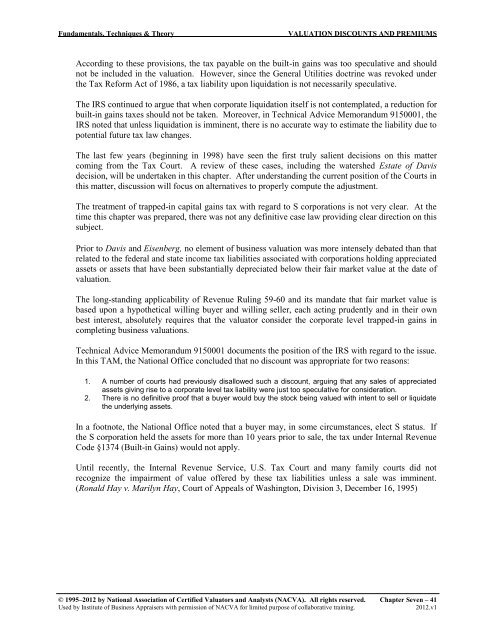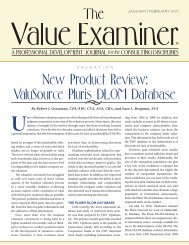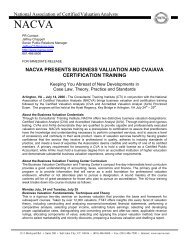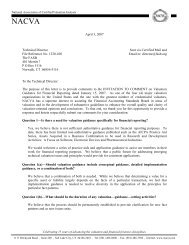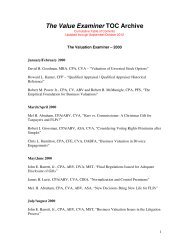VALUATION DISCOUNTS AND PREMIUMS
VALUATION DISCOUNTS AND PREMIUMS
VALUATION DISCOUNTS AND PREMIUMS
Create successful ePaper yourself
Turn your PDF publications into a flip-book with our unique Google optimized e-Paper software.
Fundamentals, Techniques & Theory<strong>VALUATION</strong> <strong>DISCOUNTS</strong> <strong>AND</strong> <strong>PREMIUMS</strong>According to these provisions, the tax payable on the built-in gains was too speculative and shouldnot be included in the valuation. However, since the General Utilities doctrine was revoked underthe Tax Reform Act of 1986, a tax liability upon liquidation is not necessarily speculative.The IRS continued to argue that when corporate liquidation itself is not contemplated, a reduction forbuilt-in gains taxes should not be taken. Moreover, in Technical Advice Memorandum 9150001, theIRS noted that unless liquidation is imminent, there is no accurate way to estimate the liability due topotential future tax law changes.The last few years (beginning in 1998) have seen the first truly salient decisions on this mattercoming from the Tax Court. A review of these cases, including the watershed Estate of Davisdecision, will be undertaken in this chapter. After understanding the current position of the Courts inthis matter, discussion will focus on alternatives to properly compute the adjustment.The treatment of trapped-in capital gains tax with regard to S corporations is not very clear. At thetime this chapter was prepared, there was not any definitive case law providing clear direction on thissubject.Prior to Davis and Eisenberg, no element of business valuation was more intensely debated than thatrelated to the federal and state income tax liabilities associated with corporations holding appreciatedassets or assets that have been substantially depreciated below their fair market value at the date ofvaluation.The long-standing applicability of Revenue Ruling 59-60 and its mandate that fair market value isbased upon a hypothetical willing buyer and willing seller, each acting prudently and in their ownbest interest, absolutely requires that the valuator consider the corporate level trapped-in gains incompleting business valuations.Technical Advice Memorandum 9150001 documents the position of the IRS with regard to the issue.In this TAM, the National Office concluded that no discount was appropriate for two reasons:1. A number of courts had previously disallowed such a discount, arguing that any sales of appreciatedassets giving rise to a corporate level tax liability were just too speculative for consideration.2. There is no definitive proof that a buyer would buy the stock being valued with intent to sell or liquidatethe underlying assets.In a footnote, the National Office noted that a buyer may, in some circumstances, elect S status. Ifthe S corporation held the assets for more than 10 years prior to sale, the tax under Internal RevenueCode §1374 (Built-in Gains) would not apply.Until recently, the Internal Revenue Service, U.S. Tax Court and many family courts did notrecognize the impairment of value offered by these tax liabilities unless a sale was imminent.(Ronald Hay v. Marilyn Hay, Court of Appeals of Washington, Division 3, December 16, 1995)© 1995–2012 by National Association of Certified Valuators and Analysts (NACVA). All rights reserved. Chapter Seven – 41Used by Institute of Business Appraisers with permission of NACVA for limited purpose of collaborative training. 2012.v1


